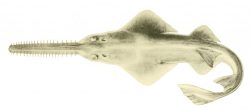select your film:


Dwarf Sawfishes inhabited a wider range in the Indian Ocean, but are now possibly restricted to tropical waters in northern Australia over sand and mud flats near mangroves. Although they can occasionally enter rivers, they do not regularly occur in freshwater. They can be found in deepwater, and at high tides, they tend to forage and rest among mangroves. Their depth ranges from one to 20 m.
Biology and Behaviour
Dwarf sawfishes grow to 32o cm in length and are the smallest species in its family. They are typically greenish-brown, or occasionally yellowish-brown on their dorsal surface with an off-white underside. They have broad, triangular pectoral fins and large, upright dorsal fins. The first dorsal fin is located directly above, or slightly behind the beginning of the pelvic fins and the caudal fin has a very small lower lobe. Their snout is broad, flat and elongated into a rostrum with about 20 pairs of rostral teeth.
They are shallow-water coastal sawfish occurring on sand and mud flats, and will sometimes enter upstream into rivers.
Dwarf sawfish usually feed on fish, but will also eat molluscs and crustaceans. Their rostrum has pores adapted for electroreception (the detection of electric fields or currents) and it’s presumably used to manipulate its prey. This electroreception sensory helps the swfish move through muddy waters.
Reproduction and Lifespan
There is little known about the reproduction of dwarf fishes. However, they are ovoviviparous and females are assumed to have a litter size of one to 13 with an average of seven pups and pups are 65 cm at birth. Males mature at about 255 to 260 cm around the age of eight. Females and males are estimated to have a lifespan of 34 years.
Estuarine waters are presumably to be the nursery areas with the young ones remaining there for three years.
Conservation and Tourism
The IUCN lists dwarf sawfishes as endangered.
Australia has implemented management measures that includes full species protection, education of fishers about safe release practices and fishery-specific management. In Australian waters, dwarf sawfish are protected, so commercial and recreational use and trade is prohibited.
Just like other sawfish, dwarf sawfish are susceptible to capture in gilders and demersal trawls because of their toothed rostrum and demersal occurrence. Additionally, their occurrence inshore make them susceptible to capture in commercial gillnet fisheries.
They are possibly extinct off the coasts of India, Indonesia, Malaysia, Papua New Guinea and Réunion.
Do you have images or videos of Dwarf Sawfishs?
Submit them to [email protected].
